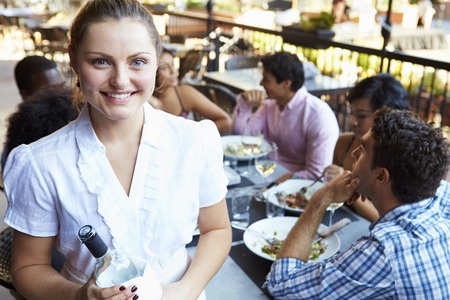Restaurant Ordering with Friends

Restaurant ordering with friends is usually fun, right? But, actually, it can be a bone of contention if everyone attending isn't in agreement on what to order, if food will be shared, and who will pay the check.
Luckily, there are etiquette guidelines to help sort out these issues and make your night out (or any occasion) with friends an enjoyable event.
Restaurant Ordering Basics
The first rule of restaurant ordering when dining with a group - large or small - is to "keep it even". This means everyone should match drinks and food courses.
If there are cocktails before the meal, everyone should order something. Even if it's a glass of water. The same goes for a round of drinks during the meal, and coffee afterwards. This does not mean that everyone must order the same drink, just that everyone should have a drink.
Matching food courses is a more obvious necessity. The flow of the meal is interrupted when one person has a first-course soup, while everyone else only ordered a main course. It's awkward to watch someone eat while you're waiting for food.
This is why pre-ordering decisions are important. Either before sitting down or while perusing the menu, you should decide as a group the number of courses you intend to order and, again, "keep it even".
Sharing Food
Good food is meant to be enjoyed and sharing a dish with someone is a wonderful way to do it.
In restaurants, many consider it appropriate to share family style. The dish comes to the table, is passed around to the right, and everyone dips a portion onto the plate in front her. If there are only two or three people at the table, the dish may be placed in the center where each person can reach to serve himself.
The glitch here is when one or two people in a group choose to order separately. Adjustments at the margin need to be made.
When individual orders are placed, but there are two people who want to share a dish, this is a less obvious issue as long as they are part of a larger group. But if there are only three of you at the table, consider ordering food that can be shared by all three.
Paying the Check with a Crowd
When you are out with a group of friends, the bill is often paid individually or per couple.
Just in case someone at the table is feeling generous, this provides an opportunity to let everyone know the meal is covered. Otherwise, it provides the opportunity to let the wait staff know ahead of time that separate checks are necessary, which is greatly appreciated.
If dining at a restaurant whose policy is one check per table, or if the group forgets to ask for separate checks, you'll need to split the check. This is easily done by dividing the total of the check by the number of people at the table and each person adding an individual tip.
But if the cost of drinks and food are not relatively equal for each person, it is more appropriate to have each diner pay his exact portion.
If you have been invited to dine in a private room at a restaurant, or for a special occasion, it is usually understood that your host will cover the check. If you are hosting such an occasion, you can eliminate any confusion by arriving before your guests to arrange payment before the festivities begin. Or, at least let the wait staff know the check should come to you.
As a guest, be prepared for anything. Just in case your meal is not covered by the host, it is best to have a form of payment with you.
Go with the Group
Meals and fun occasions go much smoother when everyone is in agreement - or at least pretends to be. Unless it is completely against your principles, go with the group.
If everyone else agrees to order appetizers for the table to share, refrain from ordering one just for yourself. If everyone agrees to split the check, pay the determined amount.
Odds are, there will be a future opportunity to share a meal with this group, and you can then politely voice your preference before you join them or decline their invitation.
Restaurant ordering with a group doesn't have to be confusing and disagreeable. Follow the guidelines above and do your best to make the meal a pleasant one no matter what.














